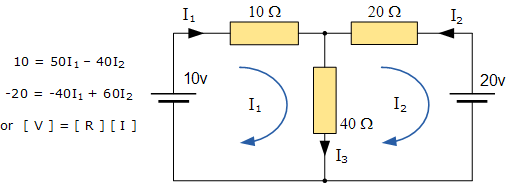
Related Term
Mesh Current Method
While Kirchhoff´s Laws give us the basic method for analysing any complex electrical circuit, there are different ways of improving upon this method by using Mesh Current Analysis or Nodal Voltage Analysis that results in a lessening of the math’s involved and when large networks are involved this reduction in maths can be a big advantage.
For example, consider the electrical circuit example from the previous section.

An easier method of solving the above circuit is by using Mesh Current Analysis or Loop Analysis which is also sometimes called Maxwell´s Circulating Currents method. Instead of labelling the branch currents we need to label each “closed loop” with a circulating current.
As a general rule of thumb, only label inside loops in a clockwise direction with circulating currents as the aim is to cover all the elements of the circuit at least once. Any required branch current may be found from the appropriate loop or mesh currents as before using Kirchhoff´s method.
For example: : i1 = I1 , i2 = -I2 and I3 = I1 – I2
We now write Kirchhoff’s voltage law equation in the same way as before to solve them but the advantage of this method is that it ensures that the information obtained from the circuit equations is the minimum required to solve the circuit as the information is more general and can easily be put into a matrix form.
Mesh Current Analysis Summary
This “look-see” method of circuit analysis is probably the best of all the circuit analysis methods with the basic procedure for solving Mesh Current Analysis equations is as follows:
-
1. Label all the internal loops with circulating currents. (I1, I2, …IL etc)
-
2. Write the [ L x 1 ] column matrix [ V ] giving the sum of all voltage sources in each loop.
-
3. Write the [ L x L ] matrix, [ R ] for all the resistances in the circuit as follows:
-
-
R11 = the total resistance in the first loop.
-
Rnn = the total resistance in the Nth loop.
-
RJK = the resistance which directly joins loop J to Loop K.
-
-
4. Write the matrix or vector equation [V] = [R] x [I] where [I] is the list of currents to be found.
As well as using Mesh Current Analysis, we can also use node analysis to calculate the voltages around the loops, again reducing the amount of mathematics required using just Kirchoff’s laws. In the next tutorial relating to DC circuit theory, we will look at Nodal Voltage Analysis to do just that.